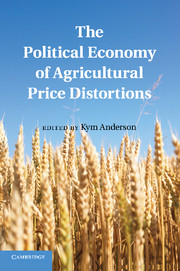Book contents
- Frontmatter
- Contents
- List of Figures
- List of Tables
- Contributors
- Foreword
- Preface
- Abbreviations and Acronyms
- PART ONE Introduction
- PART TWO CONCEPTUAL FRAMEWORKS AND HISTORICAL ORIGINS
- Part Three Political Econometrics: the Past Fifty Years
- NINE Agricultural Price Distortions and Stabilization
- TEN Why Governments Tax or Subsidize Agricultural Trade
- ELEVEN Impacts of Ideology, Inequality, Lobbying, and Public Finance
- TWELVE Agricultural Trade Interventions in Africa
- THIRTEEN Trade Agreements and Trade Barrier Volatility
- FOURTEEN Constitutional Rules and Agricultural Policy Outcomes
- Appendix: Coverage and Distribution of Assistance across Countries and Products, 1955–2007
- Index
- References
ELEVEN - Impacts of Ideology, Inequality, Lobbying, and Public Finance
Published online by Cambridge University Press: 05 July 2011
- Frontmatter
- Contents
- List of Figures
- List of Tables
- Contributors
- Foreword
- Preface
- Abbreviations and Acronyms
- PART ONE Introduction
- PART TWO CONCEPTUAL FRAMEWORKS AND HISTORICAL ORIGINS
- Part Three Political Econometrics: the Past Fifty Years
- NINE Agricultural Price Distortions and Stabilization
- TEN Why Governments Tax or Subsidize Agricultural Trade
- ELEVEN Impacts of Ideology, Inequality, Lobbying, and Public Finance
- TWELVE Agricultural Trade Interventions in Africa
- THIRTEEN Trade Agreements and Trade Barrier Volatility
- FOURTEEN Constitutional Rules and Agricultural Policy Outcomes
- Appendix: Coverage and Distribution of Assistance across Countries and Products, 1955–2007
- Index
- References
Summary
Barring very few exceptions, international trade has never and nowhere been free, even though only under extraordinary circumstances are deviations from free trade optimal. To explain this puzzle, an entire literature on the political economy of trade policy has emerged over the last three decades. In this literature, one common feature is that trade policies are chosen not with the aim of maximizing national economic efficiency and aggregate welfare, but set by politicians and policy makers whose objective functions diverge from aggregate welfare. Trade policies, in this view, are often used as indirect tools to redistribute income to certain targeted groups. The identity of these groups depends on (a) the type of political economy framework (lobbying or majority voting) assumed, (b) the actual economic, political, and geographic characteristics of the various sectors in the economy that determine which of them are politically organized, and (c) the political and economic ideology of the government.
The objective of this chapter is to explain both the cross-country variations in agricultural protection and the within-country evolution of this protection over time. The general trend has been an increase in agricultural protection in developed countries over time as their per capita incomes have increased. This protection has taken the form of tariff and nontariff barriers on imports plus substantial subsidies provided by governments to their farmers. While membership in the GATT/WTO has attempted to control the growth of such protection in developed countries, it has so far not succeeded in eliminating or reducing it.
- Type
- Chapter
- Information
- The Political Economy of Agricultural Price Distortions , pp. 278 - 303Publisher: Cambridge University PressPrint publication year: 2010
References
- 10
- Cited by



